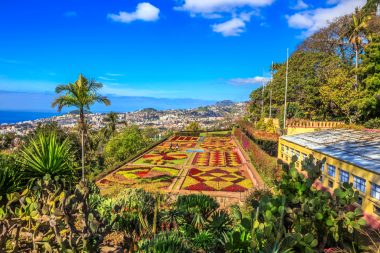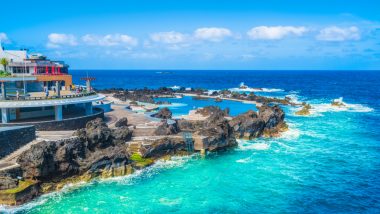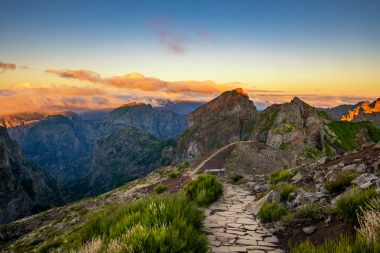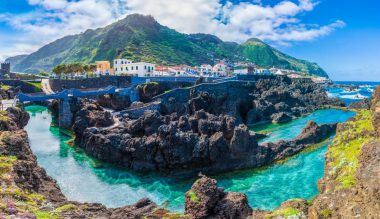Almost 1,000 kilometres from mainland Portugal , the island of Madeira in the Atlantic Ocean is closer to the coast of Africa than to the coast of Europe. Nevertheless, the Madeira archipelago, which includes the island of Porto Santo, belongs to Portugal, and thus also to the European Union. Due to its southern location, and the very favourable climatic conditions that come with it, Madeira is a year-round destination with an always pleasant climate, coupled with a magnificent nature. Which sights and excursion destinations are particularly worthwhile can be found here.
The island’s capital, Funchal

Funchal is a true jewel box that has a lot to offer architecturally and culturally. Visitors can go swimming directly on the beach boulevard in front of the pedestrian zone, or watch the sea and the cruise ships arriving from one of the many cafés there. It is worth visiting the many churches and cathedrals scattered across the city, such as the Sé Catedral de Nossa Senhora da Assunção.
The late Gothic construction was started around 1500. The high altar of the cathedral is particularly worth seeing. A steep climb leads to Nossa Senhora do Monte, a Catholic pilgrimage church in the Monte district. It was built from 1741 onwards. From here, visitors have a magnificent view down to Funchal. Right next door is the city’s famous botanical garden. Madeira is considered an island of flowers, which is not difficult to see here. On an area of 35,000 square meters, many exotic plant species cavort. The Botanical Garden is divided into themed areas, each dedicated to specific types of flowers, such as orchids. In addition, cactus species can be seen that do not thrive in the cool north. You can then return to the city with the Teleferico, the cable car that connects the lower town and the Monte district. Finally, in Rua Santa Maria, the typical colonial architecture of Funchal can be admired. In the narrow streets, which are lined with colorful houses, you will find excellent fish restaurants, bars and unique shops.
Funchal’s Museums
Certainly Madeira’s most famous son is the football star Cristiano Ronaldo. The CR7 Museum displays exhibits from his ongoing career, from fan mail to trophies and medals won, as well as jerseys and football boots.
In the Madeira Story Center, things get interactive. Visitors can relive the complete history of the island up close. Starting with the volcanic origin of the then still uninhabited island, through the discovery of Madeira by sailors in the 15th century, continuing with the importance of the island as a trading post to the more recent history of the island, a complete picture of the island is given. In addition, the Museu Quinta das Cruzes, a museum villa that gives insights into the upper-middle-class life of well-heeled merchants who founded the island’s former wealth, is recommended.
Porto Moniz

The small town in the northwest of the island was founded around 1533. In earlier times, people there earned their living with whaling. Today, the town is known for its natural pools, which were formed off the coast of the village from volcanic lava and invite you to relax all year round. On an area of 3,800 square metres, the natural pools automatically fill up with fresh seawater again and again. The solidified volcanic mass ensures that the water is always pleasantly warm. Next door, the Aquario da Madeira beckons, which shows the impressive underwater world of the island. Visitors are guided through the aquarium on a predetermined path and learn everything about the sea creatures such as starfish, crabs, crabs and several fish species native to the aquarium along the way. The aquarium is particularly popular with families with children.
The Pico do Arieiro

Madeira not only attracts friends of the sea: the island is also a hiker’s paradise. At 1,818 meters, Pico do Arieiro is the third highest mountain in Madeira and the most visited peak in the area. A well-signposted hiking trail leads from a specially installed hiking car park steeply up to the summit in about 2.5 hours. Once at the top, on a clear day, the neighboring island of Porto Santo, 50 kilometers away, can be seen. Ambitious hikers can reach Pico Ruivo within five hours via a challenging summit path from Pico do Arieiro. Surefootedness is required on the way, as the path leads past steep slopes again and again. On the way, breathtaking views into deep gorges captivate. If you are lucky, you can discover the rare Madeira petrel, which breeds alone here, in the wild.
The sister island of Porto Santo
A trip to the sister island of Porto Santo is definitely worthwhile. From Funchal, the island can be reached by ferry within about two hours. We recommend a stay of at least two days on the island, which has an interesting history to offer in addition to a continuous ten-kilometre-long sandy beach. The navigator Christopher Columbus married the daughter of the then governor of Porto Santo in 1479, and lived with his wife on the island for several years. The history of the couple can be traced in the Casa Museu Cristovão Columbo, the former home of the family. There are original objects from the sailor’s possession on display.
With a rental bike, the island can then be comfortably circumnavigated within a day. The highest elevation on the island at 517 meters, the Pico do Facho, is easy to reach and offers a magnificent panoramic view. There are also traditional windmills to see. The island is also particularly known for its numerous different varieties of passion fruit, which explicitly thrive here and can be bought by direct producers who have set up their stalls on the side of the road.



